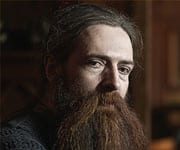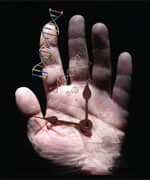Life Extension Magazine®

© Getty Images
/ Steve Pyke
Life Extension magazine® last interviewed renowned anti-aging expert Dr. Aubrey de Grey in February of 2006, and published a review of Dr. de Grey’s book Ending Aging in December 2007.
Dr. de Grey’s SENS Foundation is aggressively seeking to extend the healthy human life span.
With Dr. de Grey recently being named to the Scientific Advisory Board of the Life Extension Foundation®, we thought this would be a good time for a follow-up interview.
SENS by the way, stands for Strategies for Engineered Negligible Senescence.
The ultimate purpose of maintaining a state of negligible senescence is the postponement of age-associated disease as long as the therapies are reapplied.
LE: You have recently joined the Scientific Advisory Board of the Life Extension Foundation®. What do you hope to accomplish as a Board Member?
AdG: I’m delighted and honored to have been invited to join Life Extension Foundation’s® Scientific Advisory Board. I accepted with pleasure, because I think I can offer a range of expertise concerning biomedical research, a field that is not the sole source of Life Extension Foundation’s® business but very much does form a key component of the efforts into which Life Extension Foundation® reinvests its profits.
LE: When Life Extension magazine® interviewed you in 2006 you were managing the Methuselah Foundation. Since then you have created the SENS Foundation. Can you explain the difference between the two foundations?
AdG: The Methuselah Foundation is still run by the person with whom I co-founded it, Dave Gobel. We split it in two (forming SENS Foundation, which we have recently renamed SENS Research Foundation) in 2009 because we came to the conclusion that it was not proving efficient, from an outreach and fundraising perspective, to have one organization pursuing two very different approaches to the same mission, namely prizes (the MF’s original focus) and direct sponsorship of research. So SENS Research Foundation now handles the research sponsorship and Methuselah is mainly back on prizes. We are still on totally cordial terms and I think everyone feels that it was the right decision: both organizations have thrived since the split.
Dr. de Grey’s book outlines seven strategies for ending aging, which are based on the seven causes of aging that he has identified. They are:
- Extracellular junk
- Cell senescence
- Extracellular crosslinking
- Intracellular junk
- Mitochondrial mutations
- Cancer-causing nuclear mutations
(and epimutations) - Cell loss leading to tissue atrophy.
His program of strategies is called SENS, i.e., Strategies for Engineered Negligible Senescence. Each strategy is given a distinctive “SENS” name, as follows:
AmyloSENS (extracellular junk) – Aging leads to an accumulation of junk outside of cells, the most notorious example of which is the amyloid plaque that is believed to cause Alzheimer’s disease. AmyloSENS would attempt to use the immune system to eliminate amyloid and other damaging extracellular junk.
ApoptoSENS (cell senescence) – Cells that become old and no longer divide (senescent cells) produce inflammatory substances that contribute to many of the diseases of aging. ApoptoSENS would eliminate senescent cells by inducing such cells to “commit suicide” (apoptosis).
GlycoSENS (extracellular crosslinks) – Proteins form cross-links with sugars (glycation) as tissues age. As a result of this crosslinking, tissues lose suppleness, becoming stiff and full of fibrous material. GlycoSENS seeks enzymes that will selectively breakdown these harmful crosslinks.
LysoSENS (intracellular junk) – Waste material of various kinds (“junk”) that is formed within cells is often broken down by a specialized organelle called the lysosome, which contains enzymes for that purpose. Unfortunately, some junk (proteins, fats, metals, etc.) cannot be broken down by normal lysosome enzymes, and this junk accumulates with age. The goal of LysoSENS is to develop and provide additional enzymes to the lysosomes that would break down more forms of junk molecules.
MitoSENS (mitochondrial mutations) – Mitochondria generate energy for cells, but in doing so they generate large amounts of free radicals. A prime target for these free radicals is the DNA within the mitochondria that controls mitochondrial function. MitoSENS seeks to make copies of mitochondrial DNA in the DNA of the cell nucleus, where it would be a safe distance from the damaging free radicals produced within the mitochondria.
OncoSENS (cancer-causing nuclear mutations/epimutations) – Most forms of cancer utilize the enzyme telomerase to maintain long telomeres (the caps of chromosomes that keep them functional). OncoSENS proposes to eliminate telomerase as a means of controlling cancer. Telomeres are needed by stem cells, but OncoSENS would replace this need by a program of tissue replacement (RepleniSENS).
RepleniSENS (cell loss and atrophy) – With age, cells are lost or atrophy, thereby causing tissues to stop functioning properly. RepleniSENS would utilize stem cell therapies to restore cells and tissues.

LE: You recently inherited a large sum of money and chose to donate most of it to the SENS Foundation. Will you provide some details and explain your motives?
AdG: My mother died in May 2011 and I was her only child; the upshot is that I inherited roughly $16.5 million. Of that, I assigned $13 million to SENS (I won’t bore you with the legal details, which were tedious in the extreme). It was pretty much a no-brainer for me: I’ve dedicated my life to this mission, and I dedicate all my time to it, so why not my money too? I retained enough to buy a nice house, but beyond that I have inexpensive tastes and I have no doubt that this is the best use of my wealth. It will accelerate research considerably, and also it will have indirect benefits in terms of helping us to put more resources into raising the profile of this work and garnering more support.
LE: Who are the other major donors to the SENS Foundation, and what proportion of the budget is covered by the money you donated?
AdG: My donation will be spent over a period of about five years, and it roughly doubles the budget we had previously, from $2 million annually to $4 million. The number one external donor remains our stalwart supporter Peter Thiel. Additionally, another internet entrepreneur, Jason Hope, has recently begun to contribute comparable sums.
LE: What will the SENS Foundation do when your donation money runs out?
AdG: It’s hard to look ahead as far as five years, the projected duration of my donation, but we certainly have great confidence that our outreach efforts will bear fruit in that time. My hope is that five years from now we will be big enough that the expiry of my donation will go relatively unnoticed.
LE: Do you have a strategy for raising money for research on aging?
AdG: Absolutely—lots of strategies. The brutal lecture schedule I undertake and the 100+ interviews I do each year are part of it, as they’ve always been. The research we do, and the progress we demonstrate, are of course also key. And now that we have a little more to spend in that area, we have a really talented staff that is developing various other areas.
LE: Do you think aging is a factor that increases the risk of disease?
AdG: No, I don’t. Gerontologists will say yes, it’s a risk factor, but all they’ll mean is that there is a correlation. Non-scientists will hear the statement and will infer that with appropriate choices one can reliably avoid the diseases of old age, just as with the appropriate choices one can reliably avoid being hit by a truck when crossing the street even though crossing the street is a risk factor for being hit. As such, this is one of the most counterproductive of the many failures of communication of which I claim my colleagues in gerontology are guilty. The actual fact is that aging is the CAUSE of the diseases of old age, and we need to start saying so.
LE: Do you think research on ending aging should be distinct from research against specific aging-related diseases?
AdG: No, I certainly do not, and this leads on from the previous question. The more we appreciate that aging is the cause of age-related diseases, the more we can get the research communities that are focused on those diseases to understand that the treatment of aging is no more nor less than preventative geriatrics. The general concept of preventative medicine already has a good rap, and we need to be making use of that.
LE: What is advantageous and what is disadvantageous about the money spent on aging research by the National Institute on Aging (NIA, a branch of the US federal government’s National Institutes of Health)?
AdG: It’s pretty much all advantageous - just not nearly as advantageous as it could be. There is pitifully little money going into the search for interventions to postpone aging, and of what there is, pitifully little is focused on late-onset interventions.
LE: What do you think of the way the Ellison Medical Foundation spends money on aging research?
AdG: Exactly the same as for the NIA. The Ellison Foundation was set up with a remit to fund work that complemented the NIA, but I’m afraid to say that in practice it has merely supplemented it.
LE: Do you think it is more important for aging research to raise money from wealthy individuals than would be the case for research on cancer or heart disease?
AdG: I think wealthy individuals have a key role to play across the whole non-profit world, but probably even more in fields that so far lack widespread public support, of which the defeat of aging is unfortunately still one.
LE: For which of your SENS strategies would success achieve the most additional healthy years?
AdG: No one strategy would achieve very much on its own - certainly not as much as ten years, probably not even five.
LE: Which of the SENS strategies has the best prospect for success first?
AdG: A couple of the strategies are already in clinical trials for some relevant conditions - stem cells for various things, including Parkinson’s disease, and vaccination against extracellular debris for Alzheimer’s.
LE: Which of the SENS strategies would be the most difficult to achieve?
AdG: I think it’s pretty clear that the approaches for defeating cancer and for obviating mitochondrial mutations are the hardest, because they will both involve gene therapy, something we’re not at all good at yet. Out of those two, I would say that the OncoSENS (the elimination of telomerase enzyme) is the harder, because it is much more complex and also because it involves gene targeting rather than just insertional gene therapy.
LE: Will you make a general statement about the goal of SENS research?

AdG: SENS is based on the appreciation that there is a continuum between (a) the initially harmless, progressively accumulating damage that accumulates in the body as a side-effect of its normal operation and (b) the pathologies that emerge when the amount of that damage exceeds what the body is set up to tolerate. We want to treat (remove or obviate) the damage and thereby prevent the pathology.
LE: How difficult would it be to eliminate lipofuscin (the cellular junk that particularly accumulates in neurons and heart muscle cells) compared to eliminating 7KC (an oxidized derivative of cholesterol that accumulates in atherosclerotic plaques) or A2E (a substance accumulating in the retina with age that causes macular degeneration and blindness) as a lysoSENS project? How much difference do you think elimination of lipofuscin would make in terms of rejuvenation?
AdG: This is a big question right now. We have a PhD student in our funded group at Rice University who is working on lipofuscin, but he is just starting. Lipofuscin is indeed harder, but what makes it harder is not the aging-versus-disease distinction but simply the nature of the substance. Lipofuscin is very heterogeneous in its molecular composition, and moreover it is mainly made of proteins, so it is hard to distinguish from material that we don’t want to break down. I should note in passing that the material whose accumulation causes macular degeneration is often called lipofuscin but really should not be, because the only thing it has in common with bonafide lipofuscin is its subcellular location (the lysosome) and its fluorescence properties: its molecular composition is entirely different.
LE: In the 2011 report of the SENS Foundation, progress on mitoSENS (making copies of mitochondrial DNA in the nucleus to protect them from free-radicals generated by mitochondria) was restricted to 5 of the 13 protein-encoding mitochondrial genes. How confident are you that all 13 such genes can be copied into the nucleus in the foreseeable future? Are some of those genes more important than others, or are you simply going after the easier targets?
AdG: We’re pretty confident. Some of the genes we’ve chosen to work on first are easy targets in the sense that other researchers have demonstrated some success with them already; other genes are chosen more because success would be high-impact, in that it would allow more clear-cut assays of efficacy. In the end, all 13 are equally important.
LE: You have been demonstrating an increased appreciation for the role of neurofibrillary tangles (tangled aggregates of tau protein) as a potential cause and treatment target resulting in the cognitive decline of Alzheimer’s disease. Are you planning any SENS Foundation projects to remove tangled tau to better prevent Alzheimer’s disease than simply removing amyloid? Would this be distinct from LysoSENS (elimination of intracellular junk by more powerful enzymes in lysosomes)?

AdG: I’ve always said that (tau) tangles are likely to be just as important as (amyloid) plaques in Alzheimer’s disease, and indeed that cell loss must also be addressed. Absolutely we want to remove tangles. Tangles are an unusual type of intracellular aggregate in that they are not normally eliminated by lysosomes, but they are still a target of LysoSENS because we believe that they are the visible manifestation of a “traffic jam” caused by lysosomal dysfunction, which is itself caused by other molecules, maybe the same ones that cause atherosclerosis. (This suspicion arises from, among other things, the fact that apoE genotype is the most significant genetic contributor to risk of both Alzheimer’s disease and atherosclerosis.) At the moment we have no project in this area but we are in detailed conversations with people focused on it.
LE: Is AmyloSENS (elimination of extracellular junk, mainly amyloid) now primarily focused on transthyretin amyloid, rather than the amyloid plaques believed to cause Alzheimer’s disease? (Transthyretin is a form of amyloid that accumulates outside of the brain, especially in the heart, and has been found to be the frequent cause of death of persons over 110 years of age.)
AdG: Yes, our only AmyloSENS project at present (a collaboration between labs at Harvard and at University of Texas, Houston) is focused on transthyretin amyloid. We are leaving the research on Alzheimer’s disease amyloid to the many well-funded groups that already have it in their sights. The other main amyloid identified as having a role in Alzheimer’s disease is islet amyloid in the pancreas, and we may get into that area soon.
LE: SENS Foundation has been investigating the possibility that mutation and epimutation (changes in gene expression rather than alterations of the genes themselves) may be deleterious in ways other than cancer. If that proves to be true, what strategies do you envisage to address that problem?
AdG: Our current work is focused on epimutations; we feel that the work of experts in the field of the genetics of aging (Jan Vijg’s group at the Albert Einstein College of Medicine in particular) has already shown really conclusively that mutations accumulate far too slowly in most tissues (notably the brain) during adulthood to have any chance of contributing to age-related ill-health. If epimutations don’t come out the same way, we will need to look at ways to mildly accelerate cell turnover, combined with autologous stem cell therapy, which uses one’s own stem cells for cellular therapy. But that’s awfully hard, so let’s hope we don’t need to go there!

LE: In the November 2, 2011 issue of Nature, Darren J. Baker, et al. described success in rejuvenation of an accelerated-aging model of a mouse.* Do you think that Baker’s group is more successfully fulfilling ApoptoSENS than the SENS Foundation is likely to achieve?
AdG: The Baker paper was a huge validation of the idea that death-resistant cells are bad for you, but it didn’t actually put forward any particular approach to eliminating such cells in genetically unmodified organisms, so it in no way “fulfills ApoptoSENS.”
LE: The 2011 research report of the SENS Foundation contained only a brief mention of RepleniSENS, the use of stem cells to restore and replace cells and tissues. Given all the interest in stem cell therapies by others, is there really a need for SENS Foundation to be doing research in this area?
AdG: You’ve got it - this is the clearest example of a theme of SENS which is not being pursued aggressively by SENS Research Foundation, and that’s precisely because it’s being supported so well by others. That said, we still keep our eyes very open for specific projects in the RepleniSENS space that might need a leg up.
LE: Thank you for participating in this interview, Dr. de Grey, and we are pleased that you have joined the Scientific Advisory Board of the Life Extension Foundation®.
Dr. Aubrey de Grey is a biomedical gerontologist based in Cambridge, UK and Mountain View, California, USA, who first researched the idea for, and founded, the SENS Research Foundation. He received his BA and PhD from the University of Cambridge in 1985 and 2000 respectively, with his original field being in computer science. Dr. de Grey is Editor-in-Chief of Rejuvenation Research, a Fellow of both the Gerontological Society of America and the American Aging Association, and sits on the editorial and scientific advisory boards of numerous journals and organizations. For more information on Aubrey de Grey or the SENS organization, visit: www.sens.org.
If you have any questions on the scientific content of this article, please call a Life Extension® Health Advisor at 1-866-864-3027.
References
* Baker DJ, Wijshake T, Tchkonia T, et al. Clearance of p16Ink4a-positive senescent cells delays ageing-associated disorders. Nature. 2011 Nov 2;479(7372):232-6.

